KEY WEST, Fla. -- Living and working on the sea can be difficult and dangerous. Working under the water can be even more unforgiving. Those who dare navigate under the waves, not just on top of them, to do what the Army needs them to do are among the Special Forces' elite: combat divers.
The grueling seven-week Combat Diver Qualification Course, or CDQC, at the Special Forces Underwater Operations School in Key West, Fla., is neither for the weak of heart, or the idle of mind. It is as intense mentally as it is physically, with an attrition rate that truly begins before each class cycle does.
In order to be accepted to the course, candidates are required to pass as intense physical fitness and swim test at their home units, which must be documented by their command. So, getting there is only half the battle. For those who do make it into the course, one out of every three will never finish.
Regarded by many Soldiers as the toughest military school to endure, CDQC is run by C Company, 2nd Battalion, 1st Special Warfare Training Group, U.S. Army John F. Kennedy Special Warfare Center and School. CDQC is open to Special Forces and Ranger noncommissioned officers. Students learn surface and sub-surface waterborne infiltration methods.
The SF Underwater Operations School administers two other courses between its combat diver sessions: the Combat Diving Supervisor Course and the Diving Medical Technician Course.
IN THE BEGINNING ...
In true Special Forces tradition, the school was birthed in an autonomous fashion, and today is a self-sufficient organization with an administrative and training facility, barracks, dining facility, classrooms, parachute-drying tower, hyperbaric chamber, boat maintenance shop, docks, the largest pool in Key West, and a dive tower equipped with a nuclear submarine lockout trunk.
Three Soldiers were sent to Florida from the JFK Special Warfare Center Scuba Detachment, Fort Bragg, N.C., in the summer of 1964 with the objective to locate a site for a new underwater operations school. They selected Fleming Key, and during the next 20 years, the site grew from a collection of tents to an advanced maritime special operations training facility.
Early dive technology can also be attributed to military contributions. In 1943, an Army officer, along with other representatives from the Army, the Army Air Corps, Navy, Marine Corps and Coast Guard, helped develop a recirculating oxygen rebreather, the Lambertson Amphibious Respiratory Unit, or LARU, which gave divers the ability to travel underwater farther and for longer periods of time.
Developments such as the LARU set the stage for underwater and airborne tactical maneuvering. This infiltration method grew to become another platform for Special Forces to get to work.
Known for using cutting-edge technology, the school served as field tester in the 1970s for a rebreather unit that used mixed gas in a closed-circuit system. Of course, there are several types of equipment available now, but the school utilizes the Draeger LAR-V, which is a design based on the original LARU apparatus from the 1940s.
Master Sgt. Shane Minnick, assistant operations sergeant at SF Underwater Operations School, explained that self-contained underwater breathing apparatus or scuba diving is an open-circuit system.
"When you exhale underwater, the air, the bubbles come up to the surface. Those bubbles are easily detected," Minnick explained.
Granted, a portion of the course is dedicated to familiarizing students with open-circuit equipment. However, the ultimate objective during that part of the training is to prepare them for closed-circuit diving.
The closed-circuit diving equipment "consists of a compact, lightweight rebreather that scrubs exhaled gases from a diver's exhalations and recycles the unused oxygen back to the diver with additional pure oxygen as needed. There are no bubbles, so the system is undetectable from the surface," Minnick said.
Aside from concealing divers, there are other advantages in using a closed-circuit rebreather. Because it is so efficient in recycling and rationing oxygen, the rebreather allows combat divers to remain underwater for four hours straight. This extended amount of time allows combat divers to infiltrate strategic locations far from off-shore.
There's also a noticeable difference in buoyancy. Since the pressure of the compressed gas is reduced to fit in the tank of an open-circuit system, the air the diver breathes it in at a higher volume than it was inside the tank; hence, the diver becomes a little more buoyant with each inhalation. Alternatively, he'll descend ever so slightly with each exhalation. This discrepancy in buoyancy won't happen with a closed-circuit system because the gas re-circulates at a constant volume between the diver's lungs and the breathing bag.
ELITE COURSE
The curriculum for the CDQC has changed throughout the years. About 10 years ago, it went from a four-week course to a six-week course, incorporating pre-scuba training into the first two weeks.
Within the last year, the school underwent a review, and instructors decided to revamp the course so they could implement more valuable material that would make graduates more of an asset to their teams back home.
The most recent change now makes the course seven weeks long, which includes a "Zero Week" that puts candidates through a series of training and testing events that are conducted in the controlled environment of the pool.
One of the tests includes swimming underwater for 50 yards on just a single breath. Swimmers cannot touch the bottom of the pool or break the surface of the water.
Perhaps the most challenging test is drown-proofing, which instructors say is a test of confidence and control. They advise that the key to passing it is not to panic but to remain calm, which for some students is easier said than done.
Drown-proofing requires swimmers' hands and feet to be bound with Velcro straps. First, swimmers must bob up and down in 10 feet of water for five minutes. If they break the straps or touch the sides of the pool, they fail.
Swimmers must maintain a rhythm while doing this portion of the test. When they bob up to the surface and take in a breath of air, it must be a controlled breath. Taking in too much air will make them too buoyant, causing them to descend slower to the bottom of the pool, meaning they'll run out of air.
Furthermore, if they push off the bottom of the pool too strongly, they run the risk of breaking their restraints, which cadre says is a salient form of panic.
Next, swimmers must float on the surface for two minutes, followed by a 100-yard swim around the pool. All of these activities are in succession, and hands and feet remain bound.
Once the swim is complete, students must perform a front flip and back flip underwater in the deep end of the pool, without touching the bottom or sides for assistance. Swimmers must be careful to not deplete themselves completely, as the toughest portion of the test still remains.
As soon as candidates have completed the flips, they must grab a face mask located on the floor of the pool -- with their teeth. Once the face mask has been secured, swimmers must perform five more bobs while holding the mask in their teeth. Dropping the mask, breaking their restraints, touching the sides of the pool, or not completing the five bobs appropriately means failure.
Students are given a second chance if they fail to complete a test correctly. However, should they fail a second time, they are recycled to the next iteration of the course. Once the initial tests are completed, the course moves on at full speed.
Sgt. 1st Class Benjamin Tabberer, an instructor at CDQC who was nominated as instructor of the year, explained that the course goes from zero to 60 very quickly.
"Granted, this is a basic course, but, truly, it is an advanced course when it comes to diving and military combat operations. There is no advanced combat diver school. There is a dive supervisor course, which focuses on running a dive and making sure the divers stay safe. In essence, this course is basic, intermediate and advanced all in one," Tabberer said.
Once the pre-qualification tests are done, candidates get familiar with open-circuit equipment and do some open-water swims in the bay. Instructors say Week One weeds out those who aren't meant to be combat divers.
Weeks Two and Three are devoted to closed-circuit training, navigational diving, buddy breathing and tactical swims in full gear and equipment.
Week Four includes boat and watercraft training. For example, combat divers often use diver propulsion devices, DPDs, small, open submarines capable of carrying two divers. Minnick said that the DPD, combined with the closed-circuit rebreather, extends divers' capabilities, and they can be dropped off farther away from shore.
"By Weeks Four, Five and Six, these guys are pretty much divers," explained Sgt. 1st Class William C. Plaag Jr., who is senior instructor at SFUWO. "So at that point, they need more team training. That team training is more than just two-man buddy teams. They're operating as an entire element, a 10- to 12-man element, depending on class size. This gives the students the opportunity to work as a detachment," as they would with their groups.
With Week Five comes insertion training. This week brings together all the previous training throughout the course. Students will perform helocasts from helicopters and navigate their way by Zodiac inflatable boats to their points. Instructors said their location offers challenging navigational tests, as there are many shallow passages around the Florida Keys.
Finally, Week Six puts everything the students have learned into practical application by conducting a 48-hour field training exercise. The infiltration includes a mission for an entire team, and the instructors serve as the opposing force. Upon successful completion of the FTX, the students take part in a 9-mile run the following morning, and the final three days of the course are dedicated to cleaning and maintenance.
As one can imagine, the elation of completing such a grueling school renders the new combat divers overjoyed. The senior combat divers who teach at the school emphasize that the graduates are now, truly, the best of the best.
"The school has really come a long way. It's no longer a gateway. Graduates go back to their groups with skill sets and knowledge that run deeper than those who graduated years ago," Minnick said.
ELITE STANDARDS
Elite status can't be purchased or secured through a handout. To be elite, one must endure the hardships that tough training requires. One must train beyond the limits of what is considered the norm. One must excel. In the military, those among the elite have paid certain dues and performed to such a level that they can now be considered the top 1 percent.
The main reason combat diver qualification is so tough, Tabberer explained, "is when you take a human being, a common air-breather, put him under the water and take away his source of air - it can make the biggest, meanest, baddest human being become very weak, panic-stricken. It drains the will to survive. We're looking for people who can overcome those pitfalls and remain confident."
The school is intentionally regimented.
"We're very tight on the students. We try to identify those people who need to be here and those who don't. Usually the water does the choosing for us. We don't have to choose anything. Most of the students decide it's just not for them,"
Tabberer said. "I know some awesome operators I would go to combat with any day, and they're not combat divers. They tried the course and decided it wasn't for them."
For many students, the toughest part of the course takes place in the classroom. Master Sgt. Matthew D. Smith, chief instructor in charge of the curriculum, said that a lot of what takes place at the school involves academics.
Having a medical background might help a student in this course, but most who attend do not have that luxury. In order to fully understand the dangers involved with diving, the types of injuries that could occur and how to prevent them, students must understand basic anatomy and physiology.
The academic portion of the course, essentially, "explains what can kill these guys," Smith said solemnly.
"We go over it with a fine-tooth comb," Smith said. "A lot of times, we have to really break it down in laymen's terms. The problem is we've got a lot of 10-pound craniums walking around here who understand it in-depth. So, we spend a lot of time talking with each other about the best teaching methods."
"For example, we're not going to waste time by using a bunch of Latin terms that the students aren't going to understand. We put it into the simplest terms to get the highest level of understanding," Smith said.
"Sitting in on a class is like Valium for the ears," he joked. "These poor guys train all day and then go sit in the classroom at night. We do a lot of testing, a lot of study hall to make sure these guys understand. If one of these guys falls below 75 percent in their academics, they are placed on restriction. They must maintain a 75 percent or better, just to be able to go downtown and get a cheeseburger."
Overall course standards require an 85 percent or higher before students can qualify as divers.
"We can't just send them out of here with a 70 percent and think, 'Oh, they're probably good enough.' That's not going to work," Smith emphasized. "That kind of complacency will get a guy killed."
ELITE SOLDIERS
While virtually every instructor or staff member at the CDQC will humbly say that what they do is just another way to get to work, indeed there is something that sets apart the Special Forces combat diver from the standard Green Beret. Furthermore, not just anyone can be selected to teach at the course.
"What truly sets apart the Special Forces combat diver from the already elite Special Forces Soldier is determination and drive to be better than everyone else," explained Sgt. Maj. Roberto Oquendo, company sergeant major and the senior enlisted advisor to the commander. "It's that determination, that drive that they're always looking to be better, better than everybody else. You hear it in Special Forces and around Rangers. And you can probably find a consensus about the CDQC course as one of the hardest - mentally and physically demanding - in the Army."
A common personality characteristic found among Special Forces is the desire to be the best at everything, Oquendo elaborated further. He said that a lot of people on the street believe that being a combat diver means you're one of the best of the best. For a lot of guys, that's what they want to be.
He said occasionally some will jump into it without knowing what they're getting into exactly, but the majority of students know precisely what to expect. They researched and asked around before taking the plunge and applying for the course. They learned about the history of combat diving and what the school has to offer.
"I want to choose my words very carefully here, because this isn't for everybody, just like Airborne School is not for everybody. Not everyone who is Special Forces is [high altitude/low opening]-qualified. Of course," Oquendo pointed out, "not everyone enjoys jumping out of a plane at 13,000 feet in the air at night with equipment, and that's okay. These specialties are one notch above the standard (Special Forces duties). We need that, which is why we have these specialty teams, like dive teams and HALO teams."
Cadre members agree that potential candidates for the course must be mature, disciplined, intelligent. They must have the desire to be part of the elite one percent of Special Forces combat divers. Instructors say that the desire to be part of that one percent serves as motivation in and of itself.
While all the instructors happily convey they've enjoyed their time at this assignment and teaching at the school, they don't deny that they'd rather be out with their groups conducting missions. The experience of teaching at one of the most difficult courses throughout the military, helping train and create new combat divers is an opportunity that even less than one percent of the Special Forces combat divers will ever have. While the training mission is essential, they often look toward the future back under the water. But, the mission always comes first.
ELITE PROFESSIONALS
The Special Forces combat dive community - Army, Navy, and Air Force - has contributed more than its share to the war on terrorism, having lost several men during the course of the last few years. While they may not be called on for dive missions in the Middle East, these combat divers are fighting professionals.
In fact, most candidates who enter CDQC usually have four to seven deployments under their belts. But, it's more than special operations training and capabilities that make these men professionals. It's the heart. It's the drive. It's their sense of duty, loyalty and honor.
Having spent 10 years as an engineer in the regular Army, Tabberer decided to go Special Forces, but he said he had never considered being a diver. He explained that it was SF autonomy that pushed him through the qualification course, and the prestige that attracted him to dive school.
"Being regular Army, a commander makes your decisions. If he wants you to roll, you're rolling. But on an ODA (Operational Detachment Alpha team), you talk about it, use all your heads and brains and decide your own destiny as a team. That's what influenced me to go SF. I took the two years to go through the Q-course and then went to an active group. I saw the caliber of Soldiers and the caliber of divers, and that's what I wanted to be," he said.
Prior to then, Tabberer had never considered going to dive school.
"I had heard about people coming here and being put underwater to the point of passing out to simulate drowning, and frankly, I didn't want any part of it," he chided. But after working with combat divers in his group, he changed his mind. He said he wanted to be part of that elite force.
WHAT KIND OF SOLDIER DOES IT TAKE'
Most of the instructors at CDQC have multiple deployments as well, and some of them have given more than just time to the Global War on Terrorism. Sgt. 1st Class Thomas N. Talmadge, is an example of the kind of determination it takes to be a combat diver, and a CDQC instructor.
Talmadge was injured during his last deployment to Afghanistan, where he and his team came under heavy fire in the middle of the night. Talmadge's left leg was severely injured by a direct hit from a rocket-propelled grenade. He didn't merely catch shrapnel from the blast. Literally, the grenade hit his leg, and the unexploded round had to be yanked out of his tissue by a teammate during the firefight.
Talmadge said the chaos of the firefight made finding cover a difficult task, but once he was in a better position, the medic applied several tourniquets and called for a medevac. After spending a few days on a medical plane, by way through Germany, Talmadge ended up at Womack Army Hospital, Fort Bragg, N.C.
"That medic did everything. He saved my life," he said, adding that he's had approximately 40 surgeries to repair damage and reconstruct his leg. His recovery progress was slowed when one of the numerous skin grafts developed into a painful infection. But, Talmadge said that he has intentionally, and sometimes forcefully, taken an active part within his own recovery process, which has helped him maintain a positive outlook.
"It was life changing, especially in the beginning. You start out at the top of the food chain, but after the injury, I was at the bottom of the chain. I felt like a little bottom-sucker. Not to mention ... family comes to see you in the hospital, and you can't do anything for yourself. So, everybody's trying to help you, take care of you. It brings you down."
"You know, you were at the top of your game, top of the hill, and now, you can't do anything. Most of the time, I had a pretty good outlook on things," he confessed. "I thanked God that I was alive, but there were times that I got pretty down."
As Talmadge began regaining strength and mobility, he did laps around the nurses' station. He knew staying hydrated was extremely important, adding that he was on a liquid diet for a very long time.
Once released from the hospital, Talmadge wasn't sure about taking another regular assignment that might put him in the field.
"I could just see myself walking through a field, stepping in a hole and busting my leg open, and I'd lose all the progress I'd made so far in rehab. One of my buddies suggested I come here to CDQC as an instructor, which would allow me to continue my rehab, especially swimming," he explained.
Still walking with a cane when he first arrived to CDQC, Talmadge began swimming, and with help from the other cadre, he began running again.
"I'm almost back to the same level I was at before the injury," he said proudly, ready to get back in the fight. "I've got my feelers out there, seeing what's going on back at group, so I can get back on a team, get back to training and the daily grind."
Talmadge advises anyone who might be interested in attending or becoming an instructor at CDQC to get the ball rolling.
"Especially if you're already a diver and looking to do instructor time, this is the place to do it. Hopefully, one day, you can enjoy some of this, because it's a really good gig."
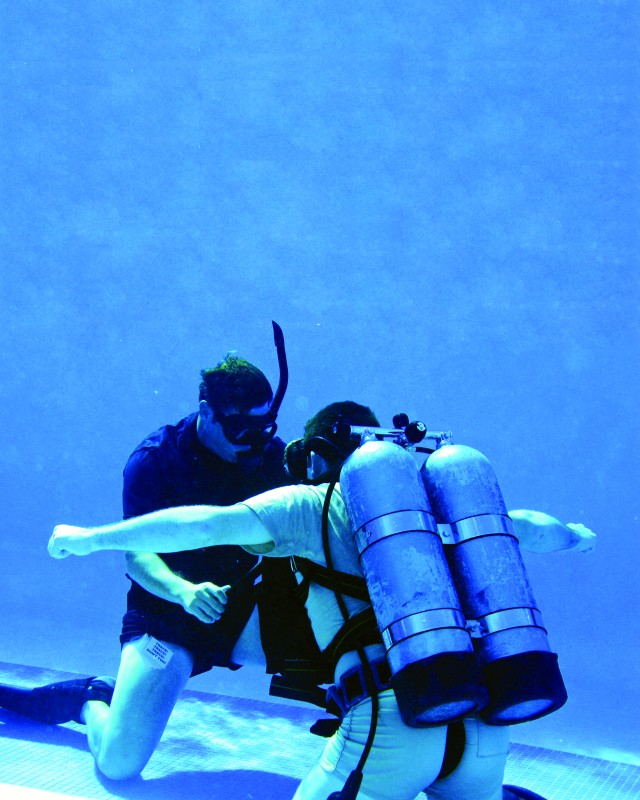
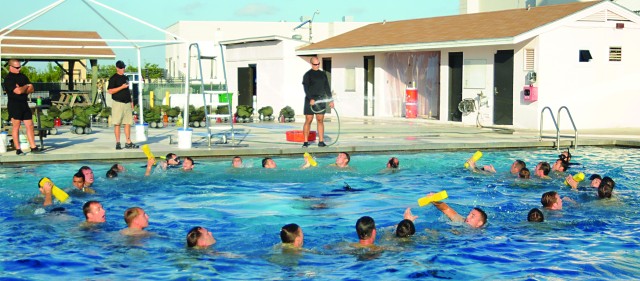
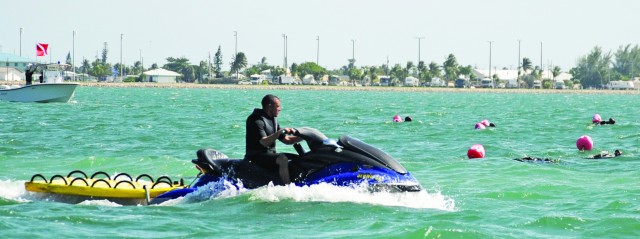

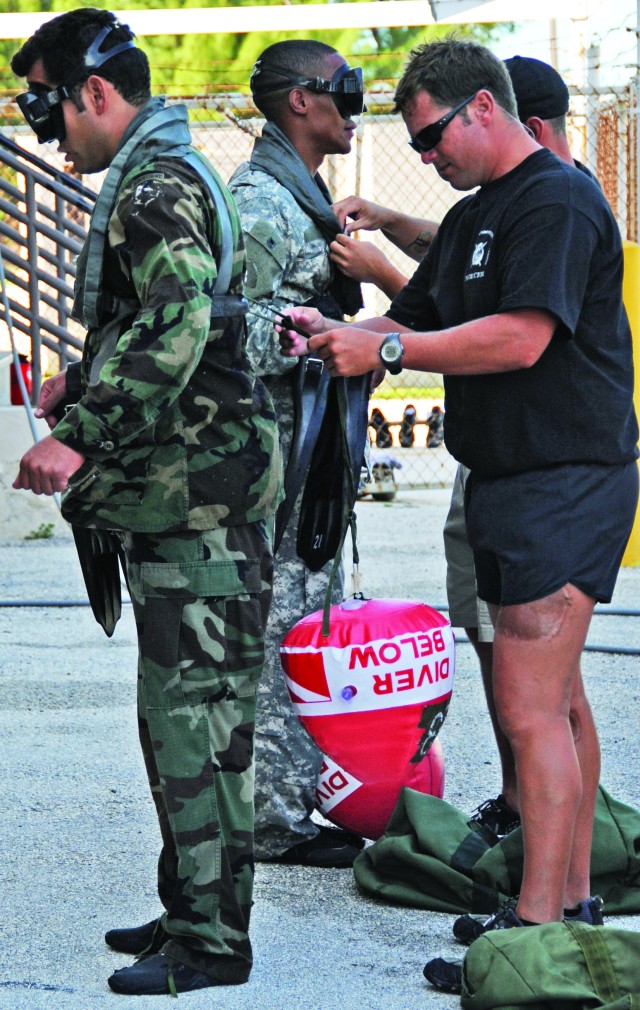
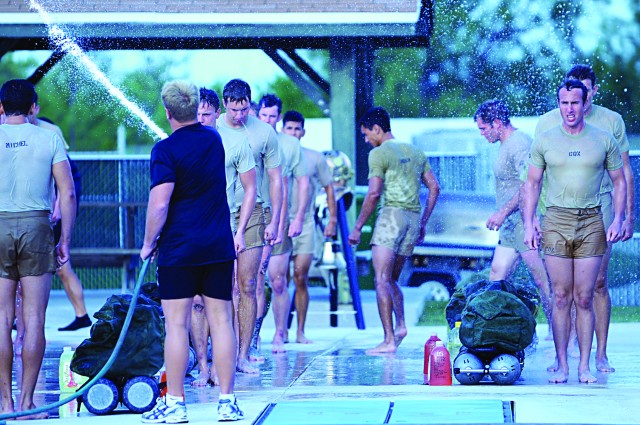
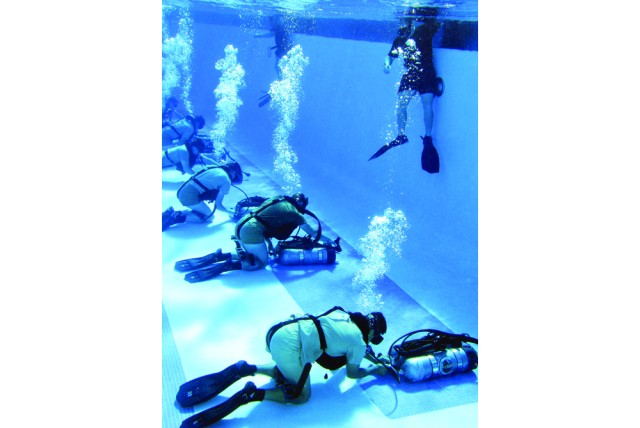
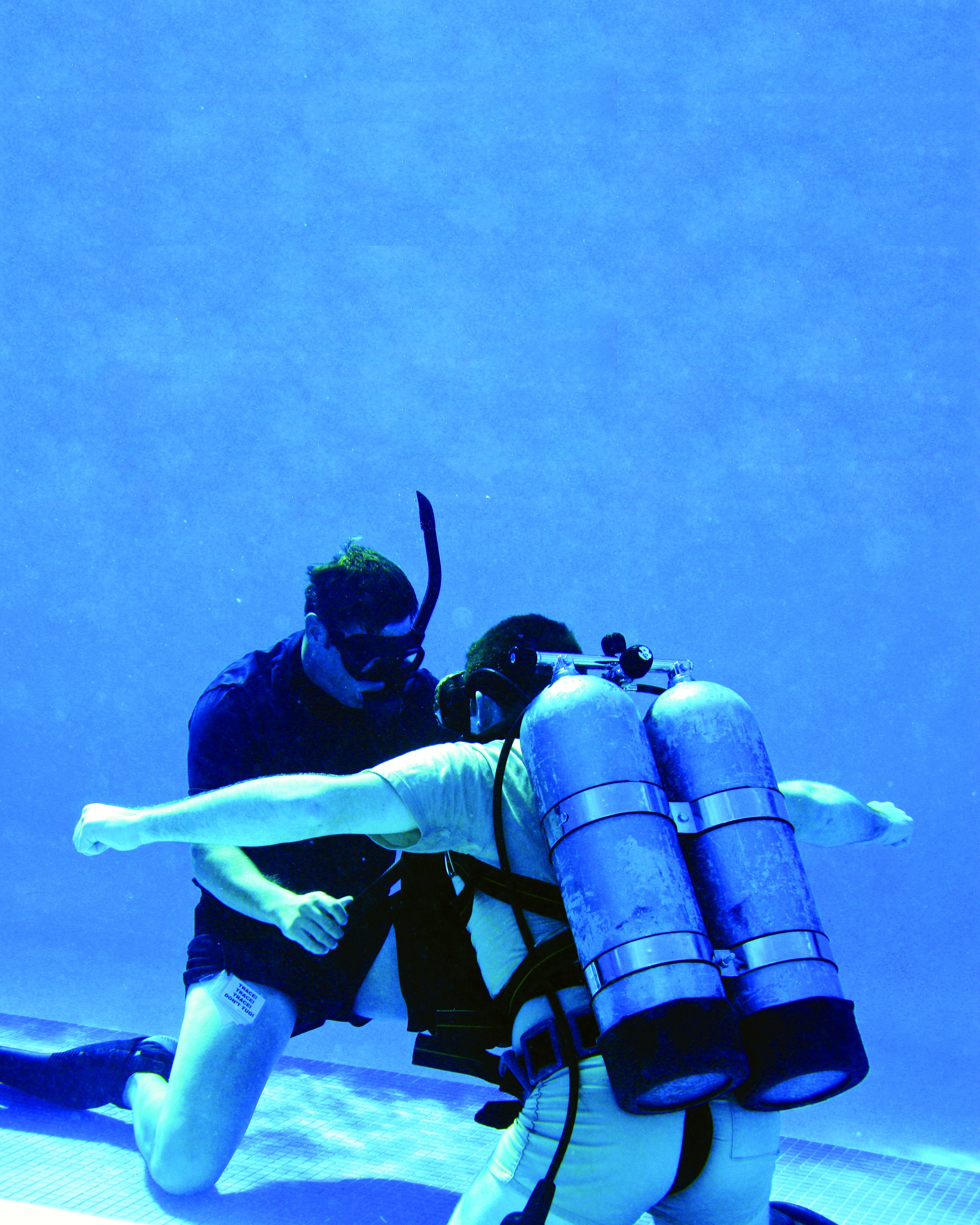
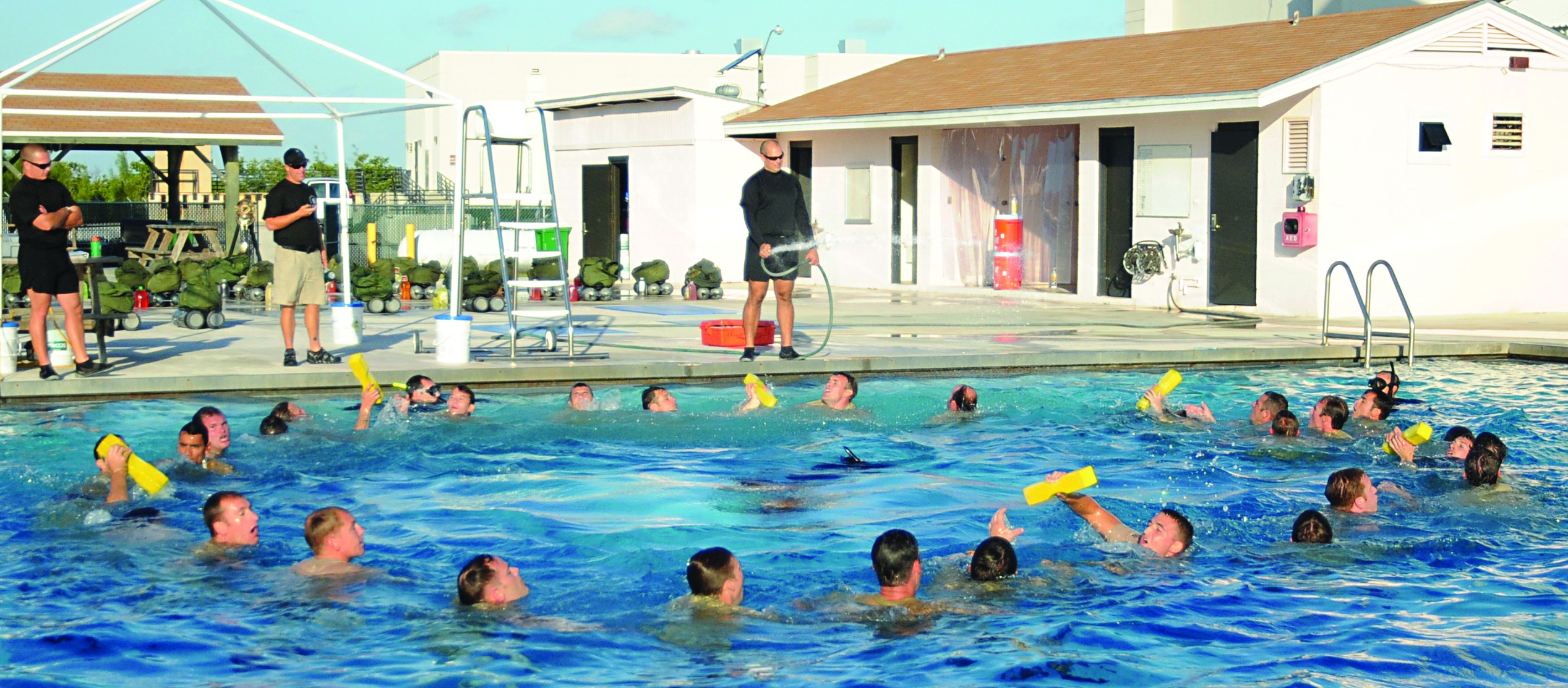

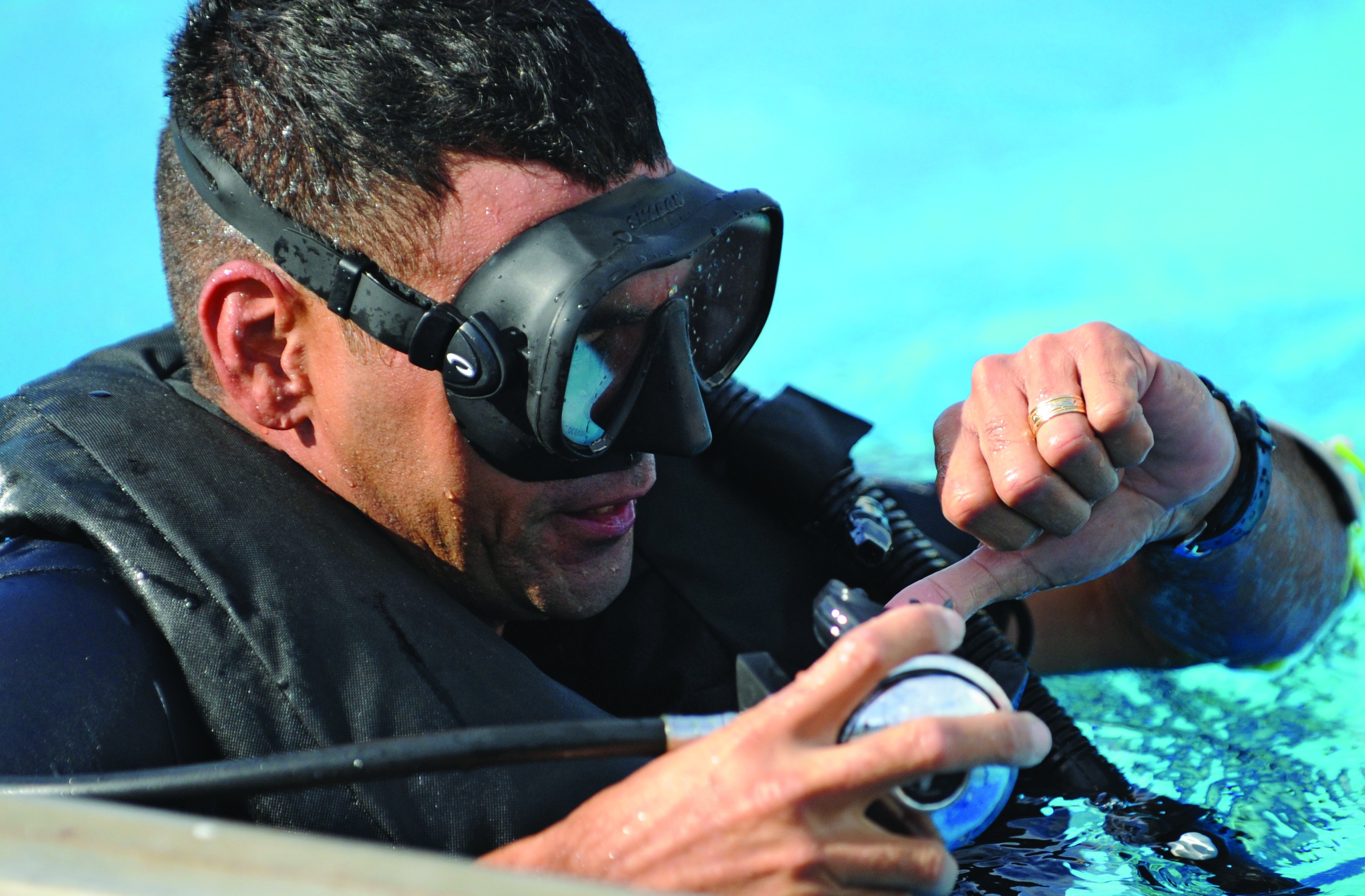
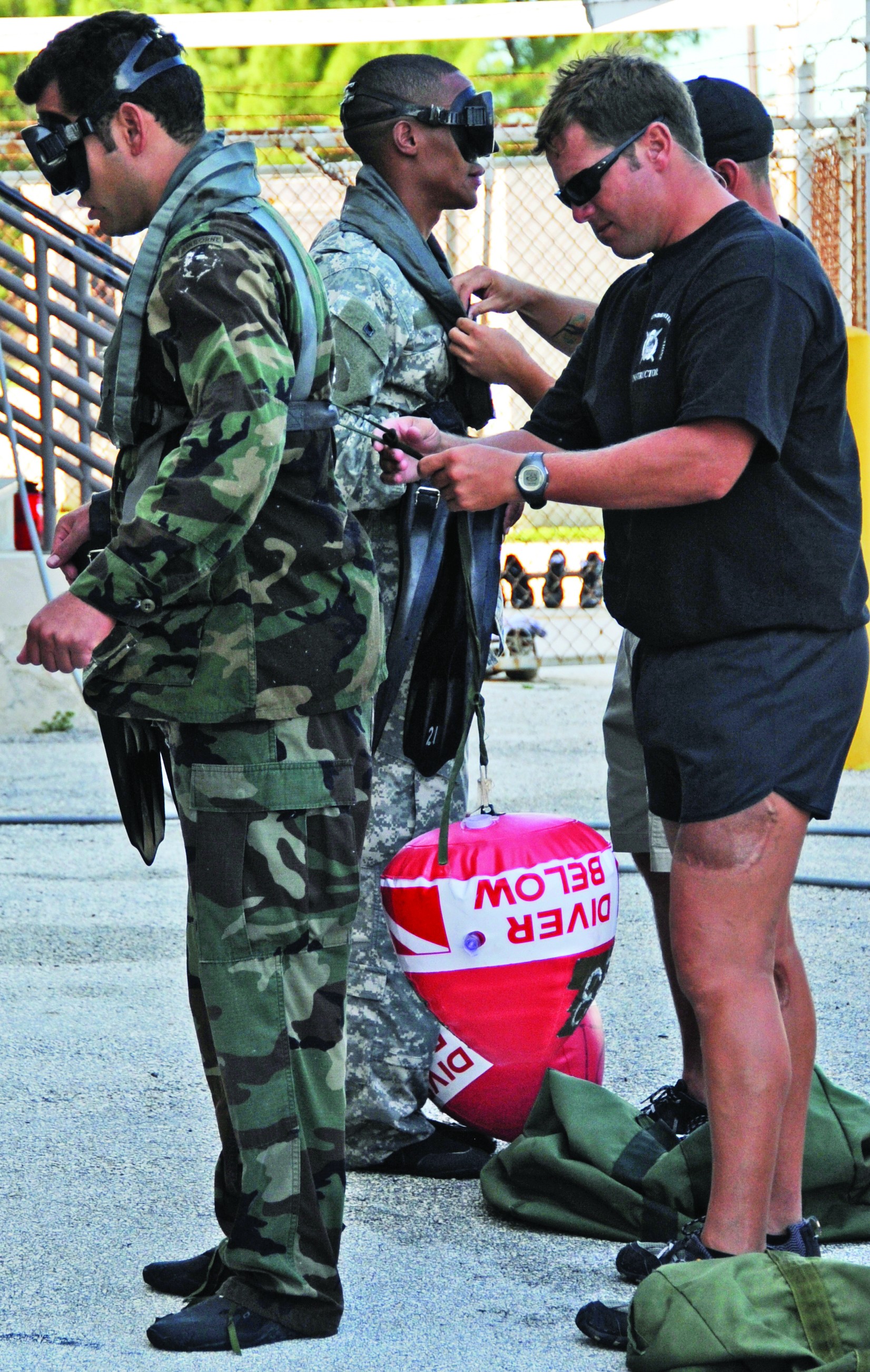
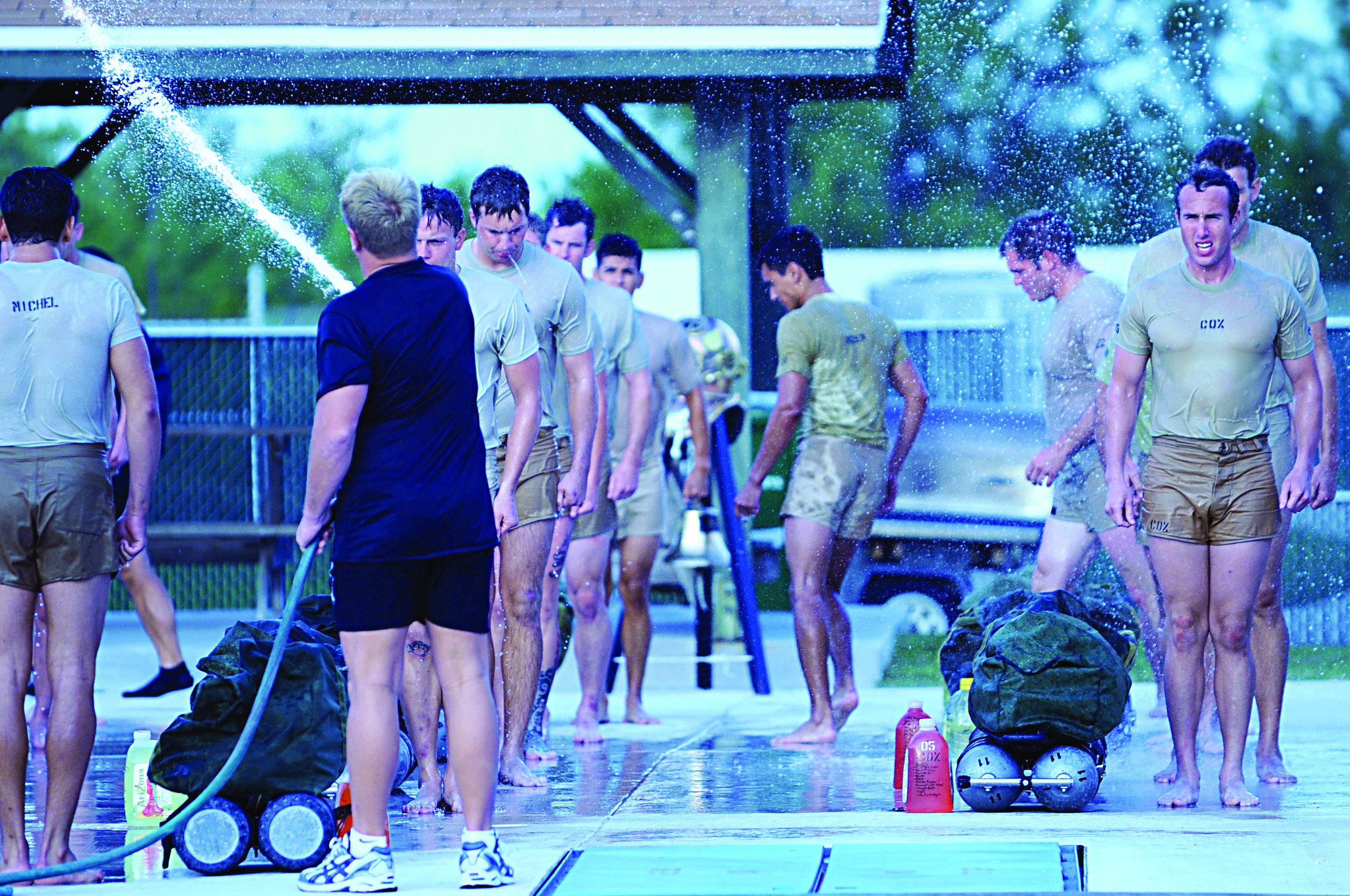

Social Sharing